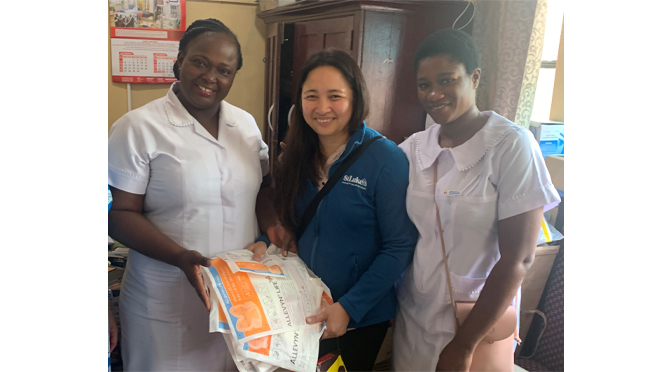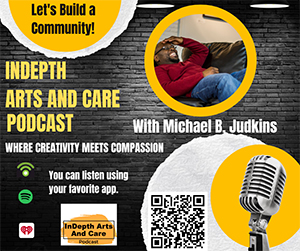Lorillie Soleta, DNP(center) teaching other nurses in Ghana, West Africa – Image provided by SLUHN
If Lorillie Soleta, DNP, had created a “Best of” list for 2024, you’d likely find her recent volunteer medical education trip to Ghana, West Africa, on it. It’s where she taught rehabilitation skills and advanced wound treatment to a group of 35 of the country’s nurses who had little or no experience in these specialties.
For a week in October, Soleta shared didactics and hand’s-on training at the Kumasi-based Komfo Anoyke Teaching Hospital (KATH). Kumasi is the second largest city in Ghana and lies 90 minutes north-west of Accra, the capital. Ghana, a country of 30 million inhabitants, lies next to the Gulf of Guinea and the Atlantic Ocean.
Many patients in Ghana suffer from pressure sores, amputation-related infections and diabetic wounds, and other skin conditions, as well as nerve-related gastro-intestinal and urologic disorders stemming from strokes and traumatic injuries. This economically and medically challenged country lacks the expertise and the resources to effectively prevent or address these and many other issues that plague this developing nation.
Soleta, who resides in Salisbury Township and holds master’s degrees in nursing and education and a doctorate in nursing practice (DNP), has been employed in St. Luke’s Wound Management Center since 2019. Smart, affable and curious, she loves medical learning and, just as much, teaching the knowledge she has acquired over the 25 years she has spent in her profession. She has worked at St. Luke’s for five years as a wound specialist and spent 13 years at Good Shepherd Rehabilitation Network as a rehabilitation specialist.
“I’m very thankful to have received good training from Dr. Michael Hortner, wound care specialist and my mentor here at St. Luke’s,” said Soleta, a native of the Philippines who immigrated to the U.S.
This was Soleta’s second trip to Ghana as an expert-invited speaker for the International Rehabilitation Forum (IRF), a non-profit, Philadelphia-based organization. According to IRF’s website, it is “committed to expanding access to Physical Medicine and Rehabilitation (PM&R), empowering all individuals with physical limitations to unlock their full leadership potential, according to IRF’s website.” She made the trip in support of the World Health Organization’s (WHO) Rehabilitation 2030 initiative.
The IRF paid her airfare, and Soleta took vacation time to go there and covered her other expenses. St. Luke’s donated free wound dressings and medications, and the St. Luke’s Simulation Center lent mannequins that Soleto used to teach rehab techniques. Soleta is thankful to her supervisor, Lindsey Rich, and Patricio Manzanares, vice president of operations, who collected and sent the medical supplies to the KATH hospital.
Using the tried-and-true nursing teaching process—see one, do one, teach one—Soleta lectured to the nurses using the 12-hour curriculum she created for the course, then gave direct patient care in a clinic setting with the nurses, who first observed, then assisted and took over the treatment.
She learned that, because of the shortage of “modern” medicine, traditional treatments for wounds and other ailments in Ghana, including ginger and hibiscus. She explained the benefit of using MediHoney, sterile gel in wound healing and was startled to learn that the local version was unfiltered and unsterile but often applied to treat wounds.
“The healthcare providers there do the best they can with the resources they have,” Soleta observed.
Back in the Lehigh Valley, in addition to her clinical activities in the hospital and outpatient clinics, Soleta often speaks on maintaining skin health and providing wound care to students at the School of Nursing and presents tutorials on these topics in area nursing homes.
She hopes to make future volunteer trips for the IRF to other countries seeking her expertise, possibly Asia or other parts of Africa, where formal wound care and rehab programs are desperately needed, but either nascent or nonexistent.
“I would love to teach this vital knowledge in needy places throughout the world,” said the wife and mother of two adult children.
Chances are, her “to do” lists in future years will include making these good-will trips, buffered by taking relaxing vacations where she can recharge, including visits to her relatives in the Philippines. It’s a balance she deftly strikes out of a love for teaching, travel and family, as she strives to help make the world a healthier place.
About St. Luke’s
Founded in 1872, St. Luke’s University Health Network (SLUHN) is a fully integrated, regional, non-profit network of more than 20,000 employees providing services at 15 campuses and 350+ outpatient sites. With annual net revenue of $4 billion, the Network’s service area includes 11 counties in two states: Lehigh, Northampton, Berks, Bucks, Carbon, Montgomery, Monroe, Schuylkill and Luzerne counties in Pennsylvania and Warren and Hunterdon counties in New Jersey. St. Luke’s hospitals operate the largest network of trauma centers in Pennsylvania, with the Bethlehem Campus being home to St. Luke’s Children’s Hospital.
Dedicated to advancing medical education, St. Luke’s is the preeminent teaching hospital in central-eastern Pennsylvania. In partnership with Temple University, the Network established the Lehigh Valley’s first and only four-year medical school campus. It also operates the nation’s oldest School of Nursing, established in 1884, and 52 fully accredited graduate medical educational programs with more than 500 residents and fellows. In 2022, St. Luke’s, a member of the Children’s Hospital Association, established the Lehigh Valley’s first and only free-standing facility dedicated entirely to kids.
SLUHN is the only Lehigh Valley-based health care system to earn Medicare’s five-star ratings (the highest) for quality, efficiency, and patient satisfaction. St. Luke’s is a Leapfrog Group and Healthgrades Top Hospital and a Newsweek World’s Best Hospital. The Network’s flagship University Hospital has earned the 100 Top Major Teaching Hospital designation from Fortune/PINC AI 10 years in a row, including in 2021 when it was identified as THE #1 TEACHING HOSPITAL IN THE COUNTRY. In 2021, St. Luke’s was also identified as one of the 15 Top Health Systems nationally. Utilizing the Epic electronic medical record (EMR) system for both inpatient and outpatient services, the Network is a multi-year recipient of the Most Wired award recognizing the breadth of SLUHN’s information technology applications such as telehealth, online scheduling and online pricing information.
Information provided to TVL by:
Sam Kennedy





